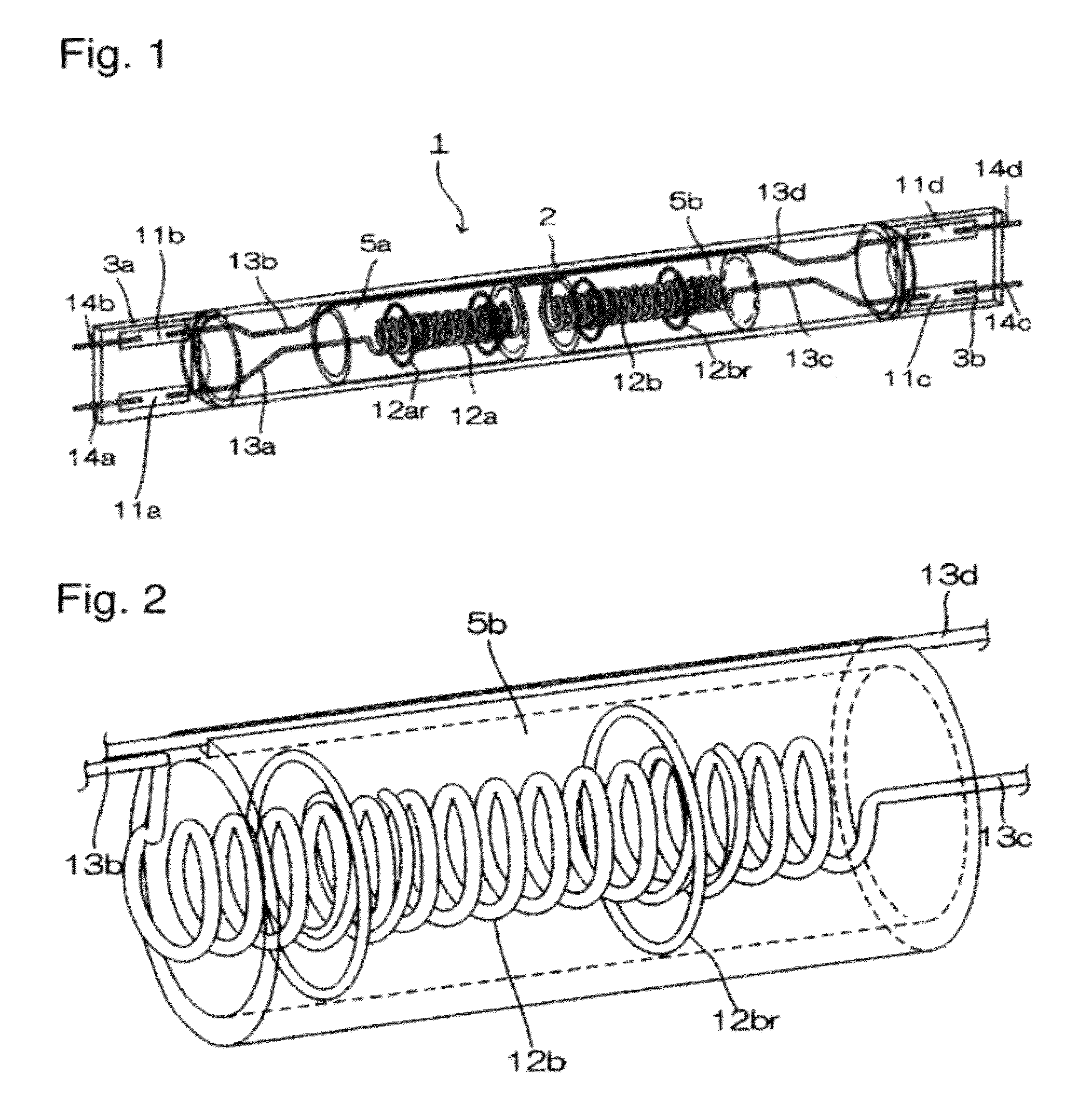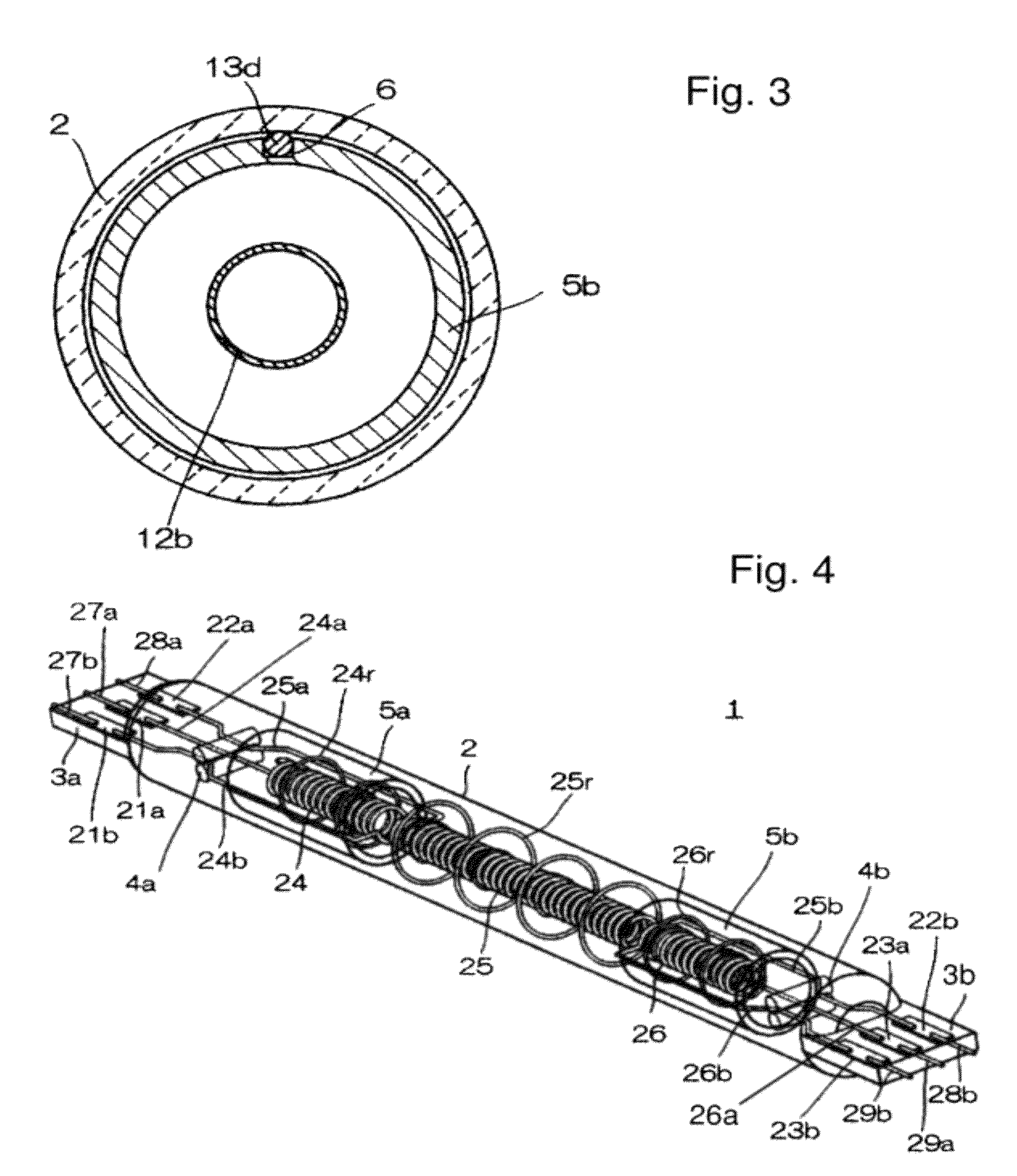Filament lamp
a filament lamp and filament technology, applied in the direction of discharge tube/lamp details, discharge tube/lamp main electrode, incadescent body mounting/support, etc., can solve the problems of non-uniformity and defective products, and achieve the effect of preventing the position of filaments to move and uniform light distribution
- Summary
- Abstract
- Description
- Claims
- Application Information
AI Technical Summary
Benefits of technology
Problems solved by technology
Method used
Image
Examples
first embodiment
[0033]FIG. 1 is a perspective view showing a filament lamp 1 according to the
[0034]The filament lamp 1 is provided with a luminous tube 2 made of light-transparent material such as quartz glass. On both ends of the luminous tube 2 are formed sealing parts 3a and 3b with pinch seals in which metal foils 11a, 11b, 11c and 11d are buried. The inside of the luminous tube is sealed air-tight. Inside the luminous tube 2, filaments 12a and 12b, which are made of tungsten, for example, and divided into two parts in the axial direction of the luminous tube 2, are provided on the same axis along the axis of the luminous tube 2.
[0035]The filament 12a is electrically connected to an internal lead 13a on its one end side that is connected to the metal foil 11a and electrically connected to an internal lead 13d on the other end side that is connected to the metal foil 11d.
[0036]As with the filament 12a, the filament 12b is electrically connected to an internal lead 13c on its one end side that i...
second embodiment
[0067]FIG. 4 shows a perspective view of the filament lamp 1 according to the
[0068]Inside the luminous tube 2 are disposed three filaments 24, 25 and 26 in the axial direction of the tube. Internal leads 24a, 24b, 26a and 26b connected to both ends of two filaments 24 and 26, which are disposed proximate to sealing parts 3a and 3b respectively, extend in the directions of the same sealing parts to be held by the sealing parts 3a and 3b, respectively. Moreover, internal leads 25a and 25b connected to both ends of the filament 25, which is disposed between two filaments 24 and 26, extend toward the opposite directions in the axial direction of the luminous tube 2 to be held at the sealing parts 3a and 3b on both ends.
[0069]Specifically, each of the internal leads 24a and 24b of the filament 24 proximate to the sealing part 3a on one end portion extend from the sealing part 3a and is connected to the end portion of the filament 24. Both of these internal leads 24a and 24b are held at t...
third embodiment
[0089]FIG. 7 is a perspective view showing the filament lamp 1 according to the
[0090]In the filament lamp 1 according to the third embodiment, as with the filament lamp 1 according to the second embodiment, internal leads 31a, 31b, 34a and 34b connected to both ends of two filaments 31 and 34, which are disposed proximate to sealing parts 3a and 3b respectively, extend in the direction of the same sealing part proximate to the filaments 31 and 34 to be held by the sealing parts 3a and 3b.
[0091]On the other hand, unlike the filament lamp 1 according to the second embodiment, at the central portion are disposed two filaments 32 and 33 to which electric power is independently supplied. Internal leads 33a and 33b connected to the filament 33 are connected to metal foils held in the sealing part 3b. Internal leads 32a and 32b connected to the other filament 32 extend in the directions of the sealing parts 3a and 3b on both ends and are held at the sealing parts 3a and 3b in such a manne...
PUM
 Login to View More
Login to View More Abstract
Description
Claims
Application Information
 Login to View More
Login to View More - R&D
- Intellectual Property
- Life Sciences
- Materials
- Tech Scout
- Unparalleled Data Quality
- Higher Quality Content
- 60% Fewer Hallucinations
Browse by: Latest US Patents, China's latest patents, Technical Efficacy Thesaurus, Application Domain, Technology Topic, Popular Technical Reports.
© 2025 PatSnap. All rights reserved.Legal|Privacy policy|Modern Slavery Act Transparency Statement|Sitemap|About US| Contact US: help@patsnap.com



